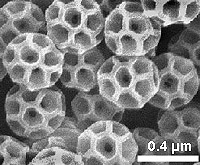
Brochosome
Encyclopedia

Leafhopper
Leafhopper is a common name applied to any species from the family Cicadellidae. Leafhoppers, colloquially known as hoppers, are minute plant-feeding insects in the superfamily Membracoidea in the order Hemiptera...
s (the family Cicadellidae of the insect order Hemiptera
Hemiptera
Hemiptera is an order of insects most often known as the true bugs , comprising around 50,000–80,000 species of cicadas, aphids, planthoppers, leafhoppers, shield bugs, and others...
) and typically found on their body surface and, more rarely, eggs. Brochosomes were first described in 1952 with the aid of an electron microscope
Electron microscope
An electron microscope is a type of microscope that uses a beam of electrons to illuminate the specimen and produce a magnified image. Electron microscopes have a greater resolving power than a light-powered optical microscope, because electrons have wavelengths about 100,000 times shorter than...
. These particles have also been found in samples of air and can easily contaminate foreign objects, which explains erroneous reports of brochosomes on other insects
Structure and composition
The name, derived from the Greek words βρóχoς (mesh of a net) and σωμα (body), refers to the characteristic reticulated surface of the granules. Most species of leafhoppers produce hollow spherical brochosomes, 0.2–0.7 micrometres in diameter, with a honeycombed outer wall. The latter often comprises 20 hexagonal and 12 pentagonal cells, making the outline of each brochosome approximating a truncated icosahedronTruncated icosahedron
In geometry, the truncated icosahedron is an Archimedean solid, one of thirteen convex isogonal nonprismatic solids whose faces are two or more types of regular polygons.It has 12 regular pentagonal faces, 20 regular hexagonal faces, 60 vertices and 90 edges....
– the geometry of a soccer ball and a C60 buckminsterfullerene
Buckminsterfullerene
Buckminsterfullerene is a spherical fullerene molecule with the formula . It was first intentionally prepared in 1985 by Harold Kroto, James Heath, Sean O'Brien, Robert Curl and Richard Smalley at Rice University...
molecule. The chemical composition of brochosomes includes proteins and, according to some studies, lipids.
Origin
Brochosomes are produced within cells of specialized glandular segments of the Malpighian tubules – the primary excretory organs of insects, which often serve additional functions. Each cell simultaneously manufactures a large number of brochosomes within its Golgi complexes and eventually releases them into the lumen of the tubule.Functions
After each molt, most species of leafhoppers release droplets of the brochosome-containing fluid through the anus and actively spread them over the newly formed integument. This behavior is called anointing. Dry brochosomes are further distributed across the body and appendages in repeated bouts of groomingPersonal grooming
Personal grooming is the art of cleaning, grooming, and maintaining parts of the body. It is a species-typical behavior that is controlled by neural circuits in the brain.- In humans :...
, in which leafhoppers scrub themselves with their legs. The transport of brochosomes is facilitated by groups and rows of strong setae on the legs. The resulting coating makes the integument highly repellent to water and to the leafhopper’s own liquid excreta, the latter often being sugary and sticky, and thus potentially dangerous for the insect. Additional protective functions of the brochosomal coating have been hypothesized .
In several New World genera of the leafhopper subfamily Cicadellinae (including the glassy-winged sharpshooter
Glassy-winged sharpshooter
The glassy-winged sharpshooter is a large leafhopper insect from the family Cicadellidae, similar to other species of sharpshooter.-Description:These sharpshooters are about in length...
and related species) brochosomes are also used as a coating to egg masses. In gravid females from these genera, the Malpighian tubules switch over from production of regular brochosomes, described above, to production of larger, typically elongate particles, up to 20 micrometres in length. Prior to laying eggs, the female places masses of such brochosomes onto its forewings, and later scrapes them off onto the freshly laid eggs with its hindlegs. The resulting powdery coat may serve various protective functions, including protection against egg-parasitoids from the order Hymenoptera
Hymenoptera
Hymenoptera is one of the largest orders of insects, comprising the sawflies, wasps, bees and ants. There are over 130,000 recognized species, with many more remaining to be described. The name refers to the heavy wings of the insects, and is derived from the Ancient Greek ὑμήν : membrane and...
(Chalcidoidea). The shape and sculpture of such “egg” brochosomes can vary significantly among species, providing additional characters for species recognition.
External links
- Brochosomes by R. A. Rakitov, Illinois Natural History Survey

